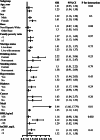The association between lymphocyte to high-density lipoprotein ratio and depression: Data from NHANES 2015-2018
- PMID: 38468463
- PMCID: PMC10928332
- DOI: 10.1002/brb3.3467
The association between lymphocyte to high-density lipoprotein ratio and depression: Data from NHANES 2015-2018
Abstract
Introduction: The relationship of lymphocyte to high-density lipoprotein ratio (LHR) with depression remains uncertain. We aimed to evaluate the association between LHR and depression in US adults.
Methods: In this cross-sectional study, a total of 4216 participants were enrolled from the National Health and Nutrition Examination Survey (2015-2018). Depressive symptoms were measured with the Patient Health Questionnaire-9 (PHQ-9). Participants were classified as having depression if PHQ-9 scores were ≥10. Multiple logistic regression models were used to explore the relationship between the LHR and depression.
Results: Overall, the LHR was significantly associated with depression (per standard deviation increment; adjusted odds ratio (OR), 1.31; 95% confidence interval (CI) [1.14, 1.50]) after adjusted potential variables. Interactions between LHR with metabolic syndrome (MetS) and body mass index (BMI) on the risk of depression were found in stratified analysis (p for interaction < .05).
Conclusions: A higher level of LHR was significantly associated with higher odds of having depression in US adults, and it was strengthened in participants with MetS or BMI ranging from 25 to 30 kg/m2 .
Keywords: depression; immune dysfunction; inflammation; lymphocyte to high-density lipoprotein ratio.
© 2024 The Authors. Brain and Behavior published by Wiley Periodicals LLC.
Conflict of interest statement
No disclosure was reported.
Figures


Similar articles
-
Cotinine, trans-3'-hydroxycotinine, and nicotine metabolite ratio indicate association between smoking and tooth loss.J Periodontol. 2025 Jul;96(7):807-816. doi: 10.1002/JPER.24-0249. Epub 2025 Jan 15. J Periodontol. 2025. PMID: 39812485
-
Prevalence and determinants of metabolic syndrome among adults living with HIV on first-line antiretroviral treatment in southern Ethiopia: a cross-sectional study.Ther Adv Chronic Dis. 2025 Jun 21;16:20406223251346289. doi: 10.1177/20406223251346289. eCollection 2025. Ther Adv Chronic Dis. 2025. PMID: 40546308 Free PMC article.
-
Association between DASH diet and metabolic syndrome in US adults: a cross-sectional study.Front Public Health. 2025 Jun 24;13:1524399. doi: 10.3389/fpubh.2025.1524399. eCollection 2025. Front Public Health. 2025. PMID: 40630403 Free PMC article.
-
Ketamine and other glutamate receptor modulators for depression in bipolar disorder in adults.Cochrane Database Syst Rev. 2015 Sep 29;(9):CD011611. doi: 10.1002/14651858.CD011611.pub2. Cochrane Database Syst Rev. 2015. Update in: Cochrane Database Syst Rev. 2021 Oct 8;10:CD011611. doi: 10.1002/14651858.CD011611.pub3. PMID: 26415966 Updated.
-
Gestational weight gain below instead of within the guidelines per class of maternal obesity: a systematic review and meta-analysis of obstetrical and neonatal outcomes.Am J Obstet Gynecol MFM. 2022 Sep;4(5):100682. doi: 10.1016/j.ajogmf.2022.100682. Epub 2022 Jun 18. Am J Obstet Gynecol MFM. 2022. PMID: 35728780
Cited by
-
Association of Three Composite Inflammatory and Lipid Metabolism Indicators With Cardiovascular-Kidney-Metabolic Syndrome: A Cross-Sectional Study Based on NHANES 1999-2020.Mediators Inflamm. 2025 May 8;2025:6691516. doi: 10.1155/mi/6691516. eCollection 2025. Mediators Inflamm. 2025. PMID: 40376312 Free PMC article.
-
Association Between Lymphocyte-High Density Lipoprotein Ratio and Cognitive Impairment in Chinese Older Adults: A Population-Based Cross-Section Study.Am J Alzheimers Dis Other Demen. 2025 Jan-Dec;40:15333175251361748. doi: 10.1177/15333175251361748. Epub 2025 Jul 30. Am J Alzheimers Dis Other Demen. 2025. PMID: 40736399 Free PMC article.
-
Association between non-high-density lipoprotein cholesterol to high-density lipoprotein cholesterol ratio (NHHR) with depressive symptoms: recent findings from NHANES 2005-2018.Front Psychiatry. 2024 Nov 5;15:1467142. doi: 10.3389/fpsyt.2024.1467142. eCollection 2024. Front Psychiatry. 2024. PMID: 39564464 Free PMC article.
-
The Prognostic Value of Hematological, Immune-Inflammatory, Metabolic, and Hormonal Biomarkers in the Treatment Response of Hospitalized Patients with Anorexia Nervosa.Nutrients. 2025 Jul 9;17(14):2260. doi: 10.3390/nu17142260. Nutrients. 2025. PMID: 40732885 Free PMC article.
-
Association between neutrophil to high-density lipoprotein cholesterol ratio (NHR) and depression symptoms among the United States adults: a cross-sectional study.Lipids Health Dis. 2024 Jul 13;23(1):215. doi: 10.1186/s12944-024-02204-y. Lipids Health Dis. 2024. PMID: 39003458 Free PMC article.
References
-
- Akboga, M. K. , Canpolat, U. , Yuksel, M. , Yayla, C. , Yilmaz, S. , Turak, O. , Ozeke, O. , Topaloglu, S. , & Aras, D. (2016). Platelet to lymphocyte ratio as a novel indicator of inflammation is correlated with the severity of metabolic syndrome: A single center large‐scale study. Platelets, 27, 178–183. 10.3109/09537104.2015.1064518 - DOI - PubMed
-
- Bensinger, S. J. , Bradley, M. N. , Joseph, S. B. , Zelcer, N. , Janssen, E. M. , Hausner, M. A. , Shih, R. , Parks, J. S. , Edwards, P. A. , Jamieson, B. D. , & Tontonoz, P. (2008). LXR signaling couples sterol metabolism to proliferation in the acquired immune response. Cell, 134, 97–111. 10.1016/j.cell.2008.04.052 - DOI - PMC - PubMed
MeSH terms
Substances
Grants and funding
LinkOut - more resources
Full Text Sources
Medical
Miscellaneous

